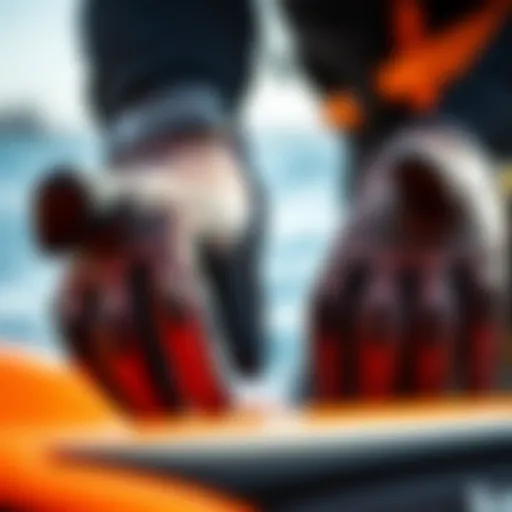A Comprehensive Exploration of Skimboarding Techniques and Culture

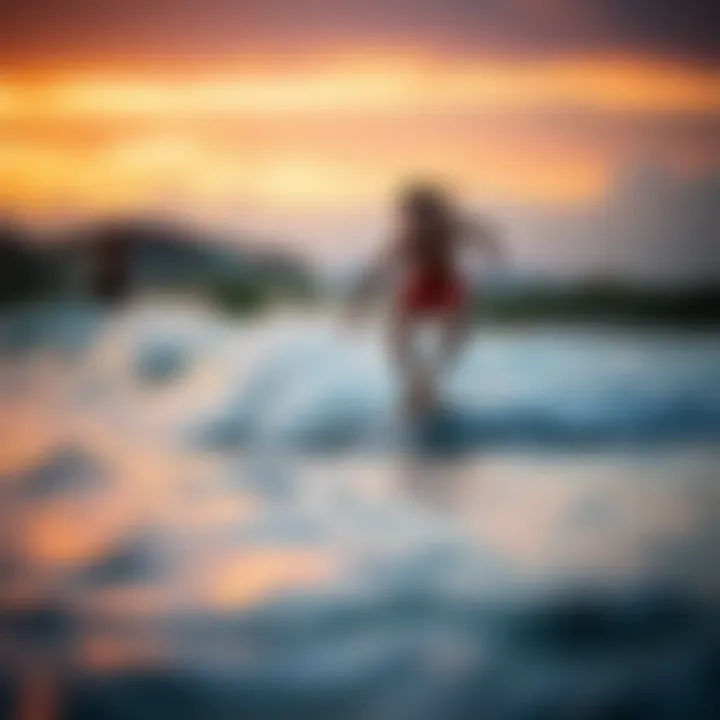
Intro
Skimboarding, often overshadowed by its more popular cousins such as surfing, has carved out a unique niche in the world of water sports. For those who are willing to give it a try, skimboarding presents an exhilarating blend of skill, agility, and creativity. It’s not just about gliding across the water; it’s a thrilling mix of artistry that challenges both body and mind.
In its essence, skimboarding revolves around riding a small board that skims on shallow water surfaces, usually at the shoreline. While the sport may seem straightforward at first glance, those who’ve sailed through the waves will attest to the complexities embedded within its techniques, safety protocols, and the gear required to make the most of the experience.
As the sun rises and waves lap against the shore, skimboarders from all walks of life congregate, determined to express themselves and push their boundaries. In this piece, we will dive into everything that skimboarding entails. From its humble beginnings to groundbreaking trends that are shaping the sport's future, this exploration aims to illuminate the rich tapestry of skimboarding, allowing both enthusiasts and newcomers a chance to truly appreciate this aquatic pastime.
Next, let’s turn our gaze to the Expert Insights, where we can position skimboarding within the broader landscape of watersports and delve into the best practices to ensure a safe and fruitful experience.
Understanding Skimboarding
Skimboarding is not just a fleeting pastime; it's a unique fusion of athleticism and creativity rolled into one exhilarating experience. The importance of grasping the essence of skimboarding lies in its multifaceted nature. For athletes, coaches, and recreationists alike, understanding skimboarding can pave the way for improved performance and enjoyment. This section will delve into what skimboarding truly means, its roots, and its cultural significance.
Definition and Basics
At its core, skimboarding involves riding a small, finless board across the surface of water, typically in shallow areas where waves are minimal. It combines elements of surfing and skateboarding, offering a thrill unlike any other. Unlike surfing, which requires riding full-fledged waves, skimboarding is often performed on a thin layer of water, allowing participants to catch a lift or perform tricks.
A crucial aspect of skimboarding is the board itself. Traditionally, skimboards are made of wood or fiberglass, though advancements in materials have led to the availability of foam options as well. The boards come in different shapes and sizes, tailored to specific styles of riding and skill levels.
Historical Background
Skimboarding has roots that trace back to the late 1920s, primarily originating in Southern California. Legendary figures such as George Freeth, credited with popularizing the sport, executed spectacular rides that mesmerized onlookers. Over the decades, skimboarding transformed from a simple activity for beachgoers into a recognized sport with its own competitive events and communities.
As the years moved forward, innovations in board design and technique fueled the growth of skimboarding. The seaside culture of California and the allure of pristine beaches made it a magnet for enthusiasts looking to enjoy the sun and waves.
Cultural Context and Popularity
The cultural significance of skimboarding extends beyond the sport itself. It embodies a lifestyle that embraces adventure and camaraderie among enthusiasts. Throughout the years, skimboarding has gained traction not just in America but across the globe, with dedicated communities popping up in countries like Brazil and Australia.
As patterns of youth culture shifted, skimboarding became a canvas for self-expression. With the rise of social media platforms, many skimmers showcased their tricks and rides, transforming skimboarding into a source of inspiration for many young athletes.
In summary, understanding skimboarding involves a deeper appreciation of its definition, historical context, and cultural relevance. It serves as a gateway into a community that values skill, creativity, and passion, making it an engaging pursuit for all involved. Learning about skimboarding not only enhances one’s own experience but also enriches the broader conversation around water sports.
Types of Skimboards
When one delves into the realm of skimboarding, understanding the various types of skimboards is crucial. The choice of a skimboard can greatly affect performance, style, and the type of tricks one can execute. In this section, we will explore three primary types of skimboards, each tailored for specific conditions and rider preferences. Not only does this knowledge empower enthusiasts to pick the right board, but it also enhances their overall skimboarding experience.
Traditional Skimboards
Traditional skimboards are the stalwarts of the skimboarding world. These boards typically measure between 45 and 55 inches in length and are designed for flatland riding and riding small waves. Made from wood, fiberglass, or epoxy, they feature a sleek, rounded shape that allows for quick maneuverability.
The appeal of traditional boards lies in their simplicity and versatility. For those new to the sport, they offer a comfortable introduction, as they are easier to control and balance. Their design caters well to beginner and intermediate riders, allowing for a variety of basic tricks such as ollies and shuvits.
Benefits of Traditional Skimboards:
- Ease of Use: Ideal for beginners to learn basic techniques without overwhelming them.
- Cost-Effective: Generally more affordable compared to specialized boards.
- Adaptability: Works well on a variety of surfaces, from wet sand to modest waves.
"Choosing the right skimboard is as important as mastering the skills. A traditional board lays the groundwork for every rider's journey."
Wider Skimboards for Tricks
Wider skimboards have emerged to cater specifically to trick practitioners and stunt enthusiasts. These boards are generally larger and have a broader surface area, which provides more stability and control during aerial maneuvers. With widths exceeding 22 inches, they allow riders to land tricks with greater precision.
The design of wider boards promotes confidence among advanced users, as they can attempt more complex tricks like flips and spins without fear of losing balance. This is particularly appealing for those who frequent competitive environments or recreational locations where showcasing skills is paramount.
Important Points about Wider Skimboards:
- Enhanced Surface Area: Increases balance during jumps and flips, minimizing the chance of wipeouts.
- Designed for Air Tricks: Tailored specifically for high-impact maneuvers that require precision landing.
- Suitable for Experienced Riders: Encourages those already familiar with the basics to push their limits further.
Innovations in Skimboard Design
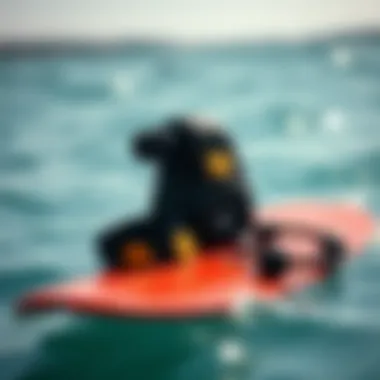
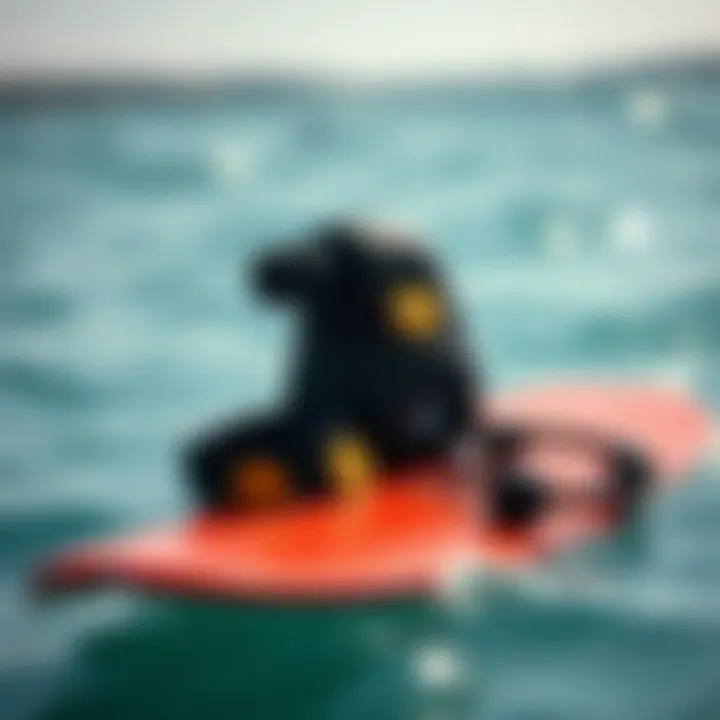
Innovation is the lifeblood of any sport, and skimboarding is no exception. Recent years have seen remarkable advancements in both materials and design technology. New boards boast features like hydrophobic coatings, which improve glide over water and reduce friction, and enhanced flexibility, enabling riders to bounce back from harder landings, transforming the way the sport is practiced.
Some of the latest models incorporate lightweight carbon fiber and other composite materials, making boards not only more durable but also nimble. There’s also a noticeable trend towards eco-friendly production methods, where manufacturers are constantly seeking ways to reduce environmental impact. The conscious consumer can now align their passion with sustainability.
Notable Innovations Include:
- Hydrophobic Finishes: Help in achieving higher speeds and smoother rides.
- Eco-Friendly Materials: Using natural fibers and recycling practices in production.
- Aerial Design Elements: Features tailored for specific stunts that revolutionize how tricks are performed.
Knowing the different types of skimboards enriches one’s surfing experience. Each board serves its purpose, and whether you are just starting or ready to take your skills to the next level, understanding these variations can make all the difference.
Essential Equipment
The right equipment makes a world of difference when it comes to skimboarding. Whether you're a beginner finding your feet or a seasoned rider looking to push your limits, having the appropriate gear not only enhances your performance but also boosts safety and enjoyment. When you step onto a skimboard, you essentially choose your partner for this thrilling dance on the waves.
Choosing the Right Skimboard
When it comes to selecting the perfect skimboard, the options can be as diverse as the ocean itself. The task isn't just to pick any board; it's about finding one that suits your style, weight, and skill level.
- Material Matters: Skimboards are commonly made from wood, fiberglass, or foam. Wooden boards offer a solid feel and are often preferred by beginners, while lightweight fiberglass boards are favored for tricks and speed.
- Size and Shape: A longer board generally provides more stability and is great for beginners. Conversely, shorter boards can be more maneuverable and suitable for advanced riders looking for height and style in tricks.
- Weight Capacity: Always check the weight limit of the board. Choosing one that matches your size helps maintain control.
The right skimboard can be the difference between a wipeout and a smooth ride. While you may be tempted by aesthetics, focusing on functionality and fit is crucial.
Safety Gear Requirements
It's easy to underestimate safety gear until you've faced a tumble in sand or surf. Investing time in procuring the correct safety equipment serves both the novice and experienced skimboarders well.
- Wetsuits: While not mandatory, these suits offer thermal insulation and protection against scrapes. They keep the body warm in chilly waters and allow for a smoother glide.
- Knee Pads: These are essential, especially for beginners, who might spend more time on their knees than their feet. A good pair of knee pads prevents injuries and makes it easier to enjoy the ride.
- Helmets: Although not typical in skimboarding, a helmet can provide an extra layer of protection, especially in more challenging environments or while performing tricks.
Don't skimp on safety; it enables you to focus on honing your skills rather than worrying about injuries.
Additional Accessories
To further enhance your skimboarding experience, consider a few extra accessories that can make a significant impact. These aren't strictly necessary, but they certainly add value.
- Board Bag: Ideal for protecting your board from scratches and dings while transporting or storing it.
- Wax: Applying wax to the top of your board improves grip, reducing the chances of slipping off during your ride.
- Beach Towel: Simple but crucial, having a towel on hand makes it easier to dry off and rest during a long day at the beach.
With the right gear and accessories, skimboarding transforms from a hobby into a full-fledged lifestyle. Understanding these essentials is the first step toward embracing the waves with confidence. Remember, preparation is key—being properly equipped leads to a more enjoyable and rewarding skimboarding experience.
"Good equipment isn't just about performance; it’s about enhancing your experience and ensuring your safety on the water."
For further insights, you can check the resources at Britannica, Wikipedia, and community discussions on Reddit.
Techniques and Skills
The realm of skimboarding is as much about finesse as it is about the thrill. Understanding the intricacies of techniques and skills isn’t just a nicety; it’s essential for anyone looking to progress in this sport. Mastering these aspects elevates your skimboarding experience, allowing for both enjoyment and safety. With every maneuver, there's an opportunity to connect deeper with the ocean and the board beneath you.
Understanding the Stance
The foundation of any successful skimboarding attempt starts with a solid stance. This is where it all begins. Imagine the stance as your first step into the dance with the waves. A good stance offers balance and control, ensuring your movements are clean and effective.
To establish the ideal stance, one needs to place feet just shoulder-width apart on the board, knees lightly bent, and weight slightly shifted to your back foot. Keeping the body relaxed but focused is key. The front foot should lie perpendicular to the board, allowing for quick responses to the undulations of the water. Adopting this stance means you’re ready to launch into any movement with confidence.
Basic Movements
Once you’re comfortable with your stance, it’s time to dive into the basic movements. Think of these as the bread and butter of skimboarding—building blocks of skills. They set the tone for your entire ride.
- Walking on Water: To start, a simple push off the shore can help you get a feel for gliding across the water. The combination of momentum and balance here is everything.
- Turning: Engaging for a left or right turn begins when you shift your weight appropriately. Lean into the turn while bending your knees to grip the board. Practice smooth transitions to avoid any jarring movements.
- Stopping: Lastly, learning to stop efficiently can save you from a face-plant. Dragging one foot gently on the sand while leaning back helps maintain control while halting your ride.
These movements might seem fundamental, but they lay the groundwork for all the more complex tricks that follow.
Advanced Tricks and Maneuvers

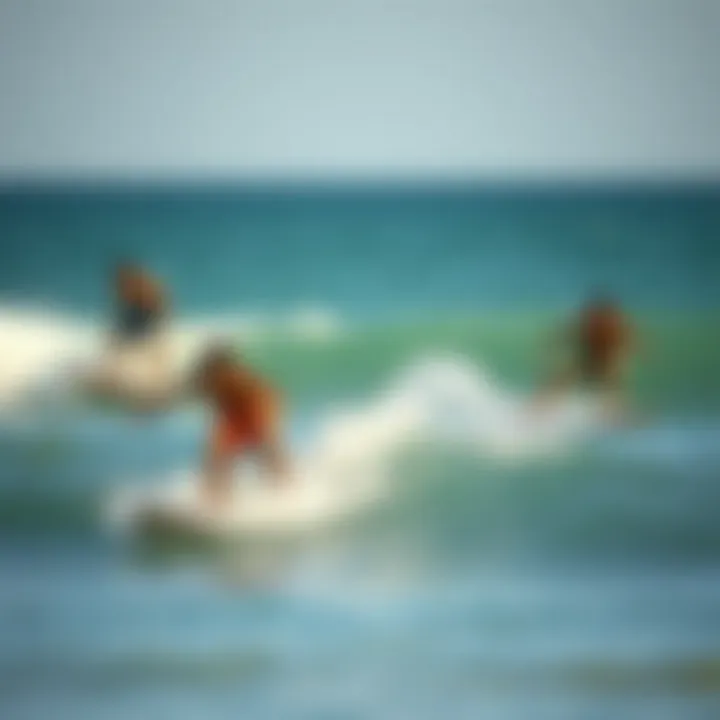
For those ready to take a leap beyond the basics, advanced tricks are where the magic unfolds. These moves not only demonstrate skill but also can leave onlookers in awe. Here are a few to consider:
- The Dolphin Dive: This maneuver involves crouching low and launching off the wave, mimicking a dolphin’s leap. The trick lies in timing your jump just as the wave breaks, allowing you to soar.
- Shuvit: A classic skateboarding move, this flip involves using your back foot to push the board while lifting it into the air. With practice, you might land back on the board cleanly.
- 360 Spin: Try spinning your body and the board simultaneously in one fluid motion. This one takes guts and practice but can elevate your presence both in the water and among peers.
Mastering these maneuvers not only boosts your confidence but also connects you with the vibrant skimboarding community.
Diving into techniques and skills in skimboarding is an ongoing journey that transforms every session into a new opportunity for growth.
Safety Considerations
Safety is paramount when it comes to engaging in skimboarding. Unlike activities that take place in controlled environments, skimboarding interacts with nature’s unpredictable elements, making awareness of safety essential. Practitioners of all levels should prioritize their well-being by understanding the risks and making informed decisions. The key components of safety considerations include identifying safe locations, comprehending local conditions, and implementing effective injury prevention strategies.
Identifying Safe Locations
Choosing the right spot for skimboarding can make all the difference. Not every beach or shoreline is appropriate for this sport. Key factors to consider include:
- Wave Size and Consistency: Look for beaches with consistent but manageable waves. For beginners, smaller, gentle waves are ideal. Conversely, more experienced skimboarders may seek out spots with larger swells, but the risk increases significantly.
- Sandy Shores versus Rocky Areas: Sand is much more forgiving than rocks. Always opt for sandy beaches to reduce the chances of injury. A rocky shoreline may look intriguing but can lead to nasty scrapes or worse.
- Crowd Levels: Skimboarding in crowded areas can pose risks, both to you and others. Choose less populated beaches where you can safely maneuver without bumping into fellow beachgoers.
Finding a balance between excitement and safety will lead to a much more enjoyable skimboarding experience. Exploring varying locations is part of the adventure, but don’t push your luck.
Understanding Local Conditions
Local conditions can change faster than the blink of an eye. Familiarizing yourself with these variations is key to avoiding mishaps. Important aspects include:
- Tide Fluctuations: Knowing when tides are high and low will help you select the best times to skim. Timing your activity with low tide not only provides a broader beach area but also less powerful swells.
- Wind Patterns: Wind can alter wave dynamics. Understanding how wind interacts with water can give you insights into the day's conditions. Windy days can create choppy waters that may not be suitable for beginners.
- Weather Forecasts: Always check local weather reports before heading out. Sudden storms can make conditions dangerous in a matter of minutes. Here, a reliable app can be a skimboarder’s best friend.
Paying close attention to local conditions ensures that every skimboarding session is fun and, most importantly, safe. Stay vigilant and aware, and let nature guide your day.
Injury Prevention
Proper precautionary measures can help mitigate injuries during skimboarding. Here are some practices worth considering:
- Warm-Up and Stretch: Just like any physical activity, taking time to warm up prevents strains and pulls. Incorporate stretching to focus on legs and core muscles, which are heavily engaged.
- Wear Protective Gear: While skimboarding doesn't usually demand extensive safety equipment, wearing items like knee pads or wrist guards can provide added protection, especially for beginners prone to falls.
- Learn to Fall Safely: In case a wipeout happens, knowing how to fall can reduce injuries. Try to avoid extending your arms to catch yourself. Instead, roll to distribute the impact and minimize potential injuries.
- Stay Hydrated and Rested: Dehydration and fatigue can influence reaction times and decision-making, increasing the chances of accidents. Always drink enough water and take breaks to recharge.
By acknowledging potential injuries and practicing prevention strategies, you create an environment conducive to fun without unnecessary risk. Safety does not detract from the thrill; it enhances your enjoyment of skimboarding!
It is always wiser to err on the side of caution than to throw caution to the wind.
Engaging in safety considerations not only protects the rider but enhances the enjoyment of the sport, allowing for growth and fun across all skill levels. Always remember to prioritize your safety and well-being no matter how experienced you become.
Environmental Impact
Understanding the environmental impact of skimboarding is crucial for fostering a sustainable relationship between this exciting sport and the natural ecosystem. As skimboarding gains popularity among beachgoers, awareness of its ecological footprint becomes more significant. Practitioners, industry stakeholders, and enthusiasts alike must consider how their activities influence the environment. The focus on sustainability not only contributes to the health of coastal areas but also enhances the overall riding experience. Let’s dive into the specific concerns and sustainable practices related to skimboarding that can minimize environmental degradation.
Ecological Concerns
Skimboarding inherently involves interaction with delicate coastal environments. The following ecological concerns often arise in relation to this sport:
- Sand Depletion: Frequent skimboarding can lead to erosion if not regulated. The constant running and landing can wear away sandy regions, diminishing habitat for coastal wildlife.
- Wildlife Disturbance: Many skimboarders might unknowingly disturb local wildlife. Nesting birds and marine life can be adversely impacted by the noise and presence of practitioners.
- Water Quality: Pollution from plastic waste and lost or discarded equipment can deteriorate water quality in areas where skimboarding is prevalent.
- Climate Change Impact: Fluctuations in weather and sea levels can impact the coasts and, consequently, the skimboarding conditions. Rising tides and extreme weather can endanger traditional skimboarding spots.
Making conscious choices can help minimize our impact and preserve these environments. Practitioners should strive to leave no trace wherever they skimboard, helping maintain the integrity of the natural world.
Sustainable Practices in Skimboarding
To ensure that skimboarding remains an enjoyable and environmentally friendly sport, several sustainable practices can be adopted:
- Use Eco-Friendly Equipment: Choose skimboards made from recycled or sustainably sourced materials. Many manufacturers are turning to greener options to craft boards that have less impact on the environment. Some brands are known for their commitment to sustainability, such as Bintangs and Noosa Skimboards, which prioritize eco-friendly materials.
- Participate in Clean-Up Events: Engage with your local skimboarding community to organize or take part in beach clean-up efforts. This fosters not only a better environment but also a sense of camaraderie among skimmers.
- Educate Others: Share knowledge about the impact of skimboarding and prioritize responsible practices. Beginners can learn about the significance of minimizing their ecological footprint and become advocates for sustainability in the sport.
- Opt for Designated Spots: Whenever possible, practice skimboarding in designated areas that manage the impact on both the beach and local wildlife. This also helps ensure that areas remain pristine and enjoyable for everyone.
“The earth has music for those who listen.” - William Shakespeare
By fostering awareness and taking action, the skimboarding community can enjoy their water sports without sacrificing the beauty of the coastal environments they cherish.

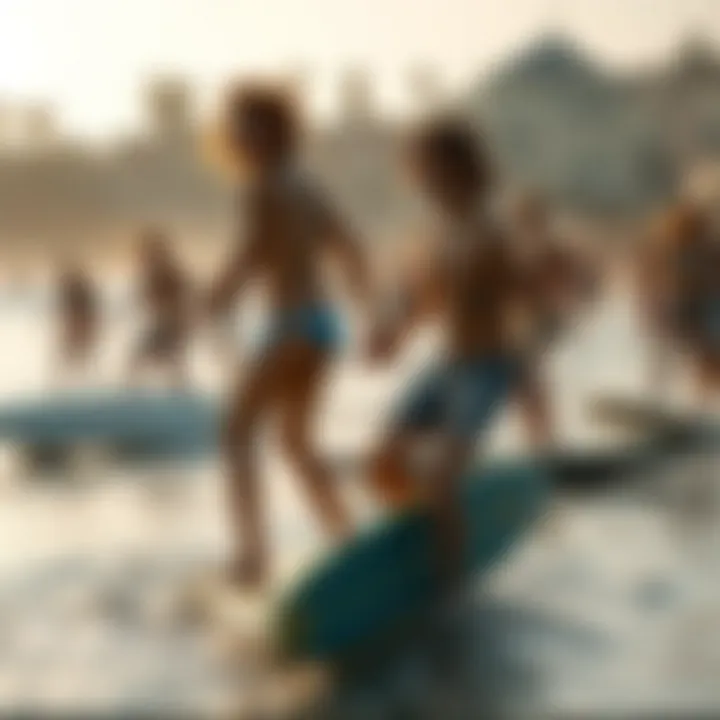
Global Skimboarding Community
The global skimboarding community has become a vibrant tapestry of cultures, techniques, and camaraderie. This network of enthusiasts cultivates a shared passion that transcends borders, allowing individuals to connect over their love for skimboarding. Understanding the essence of this community is crucial for anyone looking to immerse themselves fully into the sport, whether as an athlete, coach, or recreational enthusiast.
Major Competitions and Events
Competitions serve as the backbone of any sport, and skimboarding is no different. Events like the Skim USA Championships and the World Championships of Skimboarding draw competitors from various corners of the globe. Participating in these events isn't just about showcasing skills; it's about establishing connections, exchanging knowledge, and pushing the sport's limits.
"Competitions highlight not only individual talent but also communal growth. It's here that we learn from each other and elevate skimboarding to new heights."
These gatherings often include:
- Professional Demonstrations: Competitors display their skills through showcases of speed, tricks, and stamina.
- Workshops and Clinics: Many local legends or sponsors host sessions for newbies to enhance their skills.
- Networking Opportunities: They are platforms for manufacturers to market gear, trainers to promote lessons, and skimmers to form friendships.
Famous Skimboarders
When speaking about iconic figures in skimboarding, names like Jason Wilson and Jesse W. Forero often come up. Their contributions to the sport extend beyond the wave; they inspire countless novices and seasoned skimmers alike. Each brings a unique style and approach to skimboarding, demonstrating how varied this sport can be.
- Jason Wilson: Known for his technical prowess, he has won numerous championships and is a frequent face at global events.
- Jesse W. Forero: Often seen pushing the boundaries in stunning locations, his creativity and flair change how skimboarding is perceived.
Their presence has not only defined high standards in the sport, but it also creates aspirations among younger skimboarders. Following their journey through social media highlights the possibility of making a mark in skimboarding, encouraging up-and-comers to chase their dreams.
The Role of Online Communities
In today’s digital age, online communities have established themselves as pivotal support networks for skimboarders worldwide. Platforms like Reddit, Facebook, and specialized forums have become hubs for enthusiasts. These spaces offer several benefits:
- Information Sharing: Users exchange tips on the best techniques, gear, and spots—essential for proper skill building.
- Event Updates: Participants can stay in the loop about competitions, meet-ups, and even local beach cleanup initiatives.
- Community Support: For novices feeling overwhelmed, these platforms provide encouragement and advice, creating a sense of belonging.
Embracing these online connections can often lead to real-world relationships, transitioning virtual support into tangible experiences on the beach.
In summary, the global skimboarding community enriches the sport in multi-faceted ways. Through competitions that bring together talent and creativity, the influence of renowned skimboarders, and the accessibility of online networks, individuals at all levels can find their place within this thrilling aquatic discipline.
Future of Skimboarding
The future of skimboarding holds great promise, blending tradition with innovation. As we look ahead, several elements come into play, all contributing to the sport’s evolution. From advancements in gear and techniques to an expanded audience, the landscape of skimboarding is continually shifting. Understanding these changes is crucial for athletes, coaches, and recreationists, as they can capitalize on emerging trends, improve performance, and advocate for the sport’s sustainability.
Emerging Trends in Gear and Techniques
In skimboarding, gear is not just a tool; it significantly impacts performance. Over recent years, manufacturers have been tinkering with materials and design principles to create boards that cater to a variety of skill levels and surfing styles. Some key trends worth noting include:
- Materials Innovation: The shift towards lighter yet more durable materials, like carbon fiber and advanced polymer composites, enhances speed and agility while minimizing fatigue. With these materials, skimboards can be both strong and lightweight, offering better maneuverability in various conditions.
- Custom Designs: Skimboarders are increasingly seeking customized boards tailored to their specific style, whether it’s flatland or wave riding. Customization allows riders to achieve better balance and control, helping improve their confidence on the board.
- Tech Integration: The rise of smart wearables and electronic features is entering the skimboarding realm. Devices that track performance metrics like speed and distance are starting to make an appearance. This can aid in training routines and improve skills.
“Innovation in gear is not just about enhancing performance; it's about enriching the rider's experience.
Each advancement reflects a deeper understanding of the sport and a commitment to pushing boundaries.
Increasing Popularity Among Youth
With the burgeoning interest in skimboarding, the youth demographic is rapidly expanding. Various factors contribute to this trend:
- Social Media Influence: Platforms like TikTok and Instagram play a significant role in promoting skimboarding. Young athletes often share videos of tricks, which inspires friends and followers to try it out for themselves, creating a buzz.
- Community Events: Local competitions and beach events not only showcase skilled riders but also create an inviting atmosphere for newcomers. When kids see peers competing, it demystifies the sport and encourages babies-steps participation, fostering a growing community.
- Accessible Locations: Many coastal areas have begun constructing designated skimboarding zones, ensuring safe and engaging environments for budding enthusiasts. Seeing others enjoy the sport can diminish the intimidation factor for newcomers.
- School Programs: A few educational institutions have introduced skimboarding into their physical education programs, offering students a new and exciting way to stay active. This recognition further solidifies skimboarding as a mainstream activity, fueling interest.
As the popularity of skimboarding continues to grow among youth, so too does the potential for nurturing the next generation of skilled riders. Capturing this momentum can lead to rising competition levels and propel the sport into the spotlight.
Epilogue
In wrapping up this exploration of skimboarding, it’s crucial to reflect on the multitude of insights gleaned throughout the article. Skimboarding is not merely a sport; it’s a dynamic intersection of culture, technique, and community. The nuances of choosing the right skimboard, understanding techniques from basic stances to advanced movements, and the safety considerations have all been integral in shaping the overall skimboarding landscape. Moreover, the environmental impact and the growing focus on sustainability illustrate the sport's responsiveness to broader ecological issues.
Recapping Key Insights
To recap, we’ve traversed the definition and historical underpinnings of skimboarding, unveiling its journey from a simple pastime to a recognized water sport steeped in cultural significance. The different types of skimboards, from traditional to tricks-specific designs, demonstrate the evolution and adaptability of the equipment used. Safety is a recurrent theme in every sport, and ours is no exception; understanding safe locations, local conditions, and committing to injury prevention can greatly enhance the experience and longevity of participation.
Also, exploring the community highlights the vibrant culture surrounding skimboarding, where events and collaborations foster a sense of belonging amongst enthusiasts. Emerging trends suggest a promising future for the sport, particularly with its rising popularity among young people.
"The beauty of skimboarding lies not just in the thrill it provides, but in the connections made and lessons learned upon every wave."
Encouragement to Explore Further
As we close the chapter on this article, the journey doesn’t end here. Enthusiasts and newcomers alike are encouraged to dive deeper. Whether it’s by attending local competitions, joining online forums, or simply practicing at the beach, the opportunities for engagement with the skimboarding community are abundant. Resources such as Wikipedia, Britannica, and forums on platforms like Reddit provide valuable insights and updates on the latest happenings in the world of skimboarding. Remember, every ride on that board is a chance to learn, thrive, and connect. Start your adventure today and discover what skimboarding can offer you.







